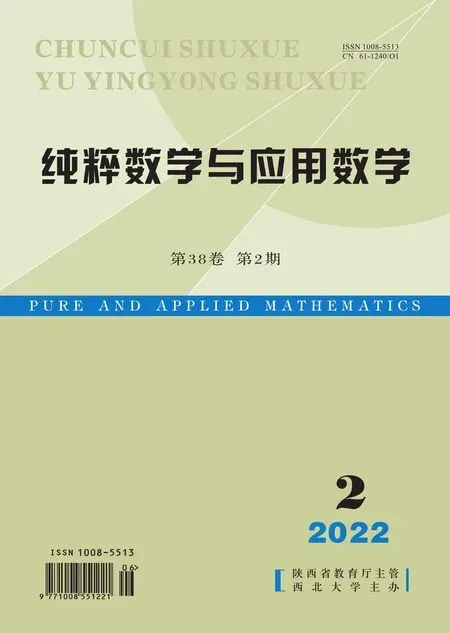The uniqueness of the strong general type algebroid functions concerning small functions
2022-08-02TanYang
Tan Yang
(School of Applied Mathematics,Beijing Normal University,Zhuhai 519085,China)
Abstract:The uniqueness of algebroid functions is an important subject in the value distribution theory.But for multiple valued algebroid function,the uniqueness achievements of algebroid functions are fewer than those of meromorphic functions.The uniqueness of meromorphic functions sharing small functions has been completely solved,the uniqueness of algebroid functions sharing small functions is worthy of further study.In this paper,we investigate the uniqueness of the strong general type algebroid functions concerning small meromorphic functions.We get several uniqueness theorems,these results extend some uniqueness theorems of meromorphic functions concerning small meromorphic functions to the strong general type algebroid functions.
Keywords:algebroid function,uniqueness,small function
1 Introduction
In this paper,we use C to denote the complex plane,C to denote the extended complex plane.Letf(z)andg(z)be two nonconstant meromorphic functions in the complex C,and letα(z)be a nonconstant meromorphic function in C or a constant.We say thatf(z)andg(z)shareα(z)CM in X⊆C provided that in Xf(z)-α(z)andg(z)-α(z)have the same zeros counting multiplicities.Similarly,we say thatf(z)andg(z)shareα(z)IM in X⊆C provided that in Xf(z)-α(z)andg(z)-α(z)have the same zeros ignoring multiplicities.

Letf(z)be a nonconstant meromorphic function in the complex C.A meromorphic functionα(z)in C is called a small function with respect tof(z)if possibly outside a setEofrof finite linear measure.We useS(f)to denote the set of meromorphic functions in C which are small functions with respect tof(z).Obviously,S(f)is a field and contains C.
Similarly,letW(z)andM(z)be two algebroid functions in the complex C andα(z)be a nonconstant meromorphic function in C or a constant.We denote


are the zeros ofW(z)-α(z)and which are also the zeros ofM(z)-α(z)ignoring multiplicities;We denote multiplicities zeros ofW(z)-α(z)and which are also at least theτn(n=1,2,···)multiplicities zeros ofM(z)-α(z).We say thatW(z)andM(z)shareα(z)IM in X⊆C provided that in XW(z)-α(z)=0⇔M(z)-α(z)=0.We say thatW(z)andM(z)shareα(z)CM in X⊆C provided that in XW(z)-α(z)=0⇌M(z)-α(z)=0.
LetW(z)be an algebroid function in the complex C.A meromorphic functionα(z)in C is called a small function with respect toW(z)ifT(r,α(z))=o(T(r,W(z)))asr→∞,possibly outside a setEofrof finite linear measure.We useS(W)to denote the set of meromorphic functions in C which are small meromorphic functions with respect toW(z).
LetAv(z),Av-1(z),···,A0(z)be a group of holomorphic functions which have no common zeros,then the irreducible equation

defines av-valued algebroid function.
(i)IfAv(z),Av-1(z),···,A0(z)are a group of linearly independent holomorphic functions,then(1)defines av-valued general type algebroid function.
(ii)αv(z),αv-1(z),···,α0(z)∈S(W)are a group of meromorphic functions,ifthen(1)defines av-valued strong general type algebroid function.
Similarly,we define aμ-valued algebroid function as follows

Thev-valued algebroid functionW(z)has two kinds of critical points:
(1)The rootz0satisfies the equationAv(z)=0;
(2)The common rootz0satisfies both the equation

Namely,z0is a multiple root of the equationψ(z,W)=0.
We use the notationsSzandTz=CSzto denote the set of critical points and the set of normal points of thev-valued algebroid functionW(z).Since each critical pointz0of thev-valued algebroid functionW(z)is an isolated point and|(z-z0)vW(z)|is bounded at the neighborhood ofz0,they are removable singularities or poles.So thev-valued algebroid functionW(z)is continuous according to the spherical metric on the sphere.Then we study the properties of thev-valued algebroid functionW(z)only onTz.
The single valued domain of av-valued irreducible algebroid functionW(z)is a connected Riemann surfaceThe point on the connected Riemann surfaceis the regular function elementwherewb,j(z)denotes an analytic function in the discB(b,r).There exists a pathfor any two regular function elements(wb,j(z),B(b,r))and(wa,t(z),B(a,r))to extend analytically to each other.We often write
LetW(z)be av-valued algebroid function,we use the notations:

wherewj(z)(j=1,2,···,v)is a one-valued branch ofW(z).
Remark 1.1LetW(z)andM(z)bev-valued andμ-valued algebroid functions determined by(1)and(2).
n0(r,a)denotes the common values ofW(z)=aandM(z)=ain|z|<rcounting multiplicities.Let

There are abundant the uniqueness achievements of meromorphic functions[1-6].As extention of meromorphic function,the uniqueness of algebroid functions is an important subject in the value distribution theory.But for multiple valued algebroid function,owing to the complexity of its branch points,the uniqueness achievements of algebroid functions are fewer than those of meromorphic functions.
Reference[7]proved the following well-known theorems:
Theorem 1.1[7]Letf(z)andg(z)be two nonconstant meromorphic functions in the complex C.If they share five distinct valuesIM in the whole complex plane C,thenf(z)≡g(z).
Question 1.1Does Theorem 1.1 hold ifaj(j=1,2,···,5)instead of five distinct elements in
Dealing with this question,many mathematicians came into the study of this subject.Reference[5]solved this problem thoroughly.
Theorem 1.2[5]Letf(z)andg(z)be two nonconstant meromorphic functions in the complex C.If they share five distinct elements(j=1,2,···,5)IM in the whole complex plane C,thenf(z)≡g(z).
The uniqueness problem of algebroid functions was firstly considered by Reference[8]which obtained a famous 4v+1-valued theorem of the uniqueness of algebroid functions:
Theorem 1.3[8]LetW(z)andM(z)be twov-valued algebroid functions,ifW(z)andM(z)shareaj∈(j=1,2,···,4v+1)CM,thenW(z)≡M(z).
Afterwards some scholars have discussed the uniqueness problem of algebroid functions[9-15],they have got some achievements of algebroid functions.Reference[15]obtained the following theorem:
Theorem 1.4[15]LetW(z)andM(z)bev-valued andμ-valued algebroid functions andμ≤v,aj∈(j=1,2,···,4v+1)are 4v+1 distinct complex numbers.IfW(z)andM(z)shareaj∈(j=1,2,···,4v+1)IM,thenW(z)≡M(z).
Question 1.2Does Theorem 1.4 hold ifaj(j=1,2,···,4v+1)instead of 4v+1 distinct elements in(S(W)∩S(M))∪{∞}?
We know the proof of Theorem 1.4 depends on the second fundamental theorem of algebroid functions.Reference[16]obtained the second fundamental theorem of the strong general type algebroid functions concerning small meromorphic functions.They solved this problem partially.
Theorem 1.5[16]LetW(z)be av-valued strong general type algebroid function,αj(z)(j=1,2,···,q)∈S(W)∪{∞}are a group of distinct meromorphic functions,then

whereεis a sufficiently small positive number.
In this paper,we will investigate the uniqueness of the strong general type algebroid functions on the basis of the Theorem 1.5.
2 Some Lemmas
Lemma 2.1[15]LetW(z)be av-valued algebroid function defined by(1)anda∈C,then

3 Main Results
Theorem 3.1LetW(z)andM(z)bev-valued andμ-valued strong general type algebroid functions defined by(1)and(2)on the complex plane C respectively andμ≤v,α(z)∈(S(W)∩S(M))∪{∞}.If

then we haveW(z)≡M(z).
ProofNow letW(z)andM(z)bev-valued andμ-valued strong general type of algebroid functions determined by(1)and(2)on the complex plane C respectively andμ≤v.IfW(z)(z),then we have

R(ψ,φ)denotes the resultant ofψ(z,W)andφ(z,M),it can be written as the following

It can be written in another form
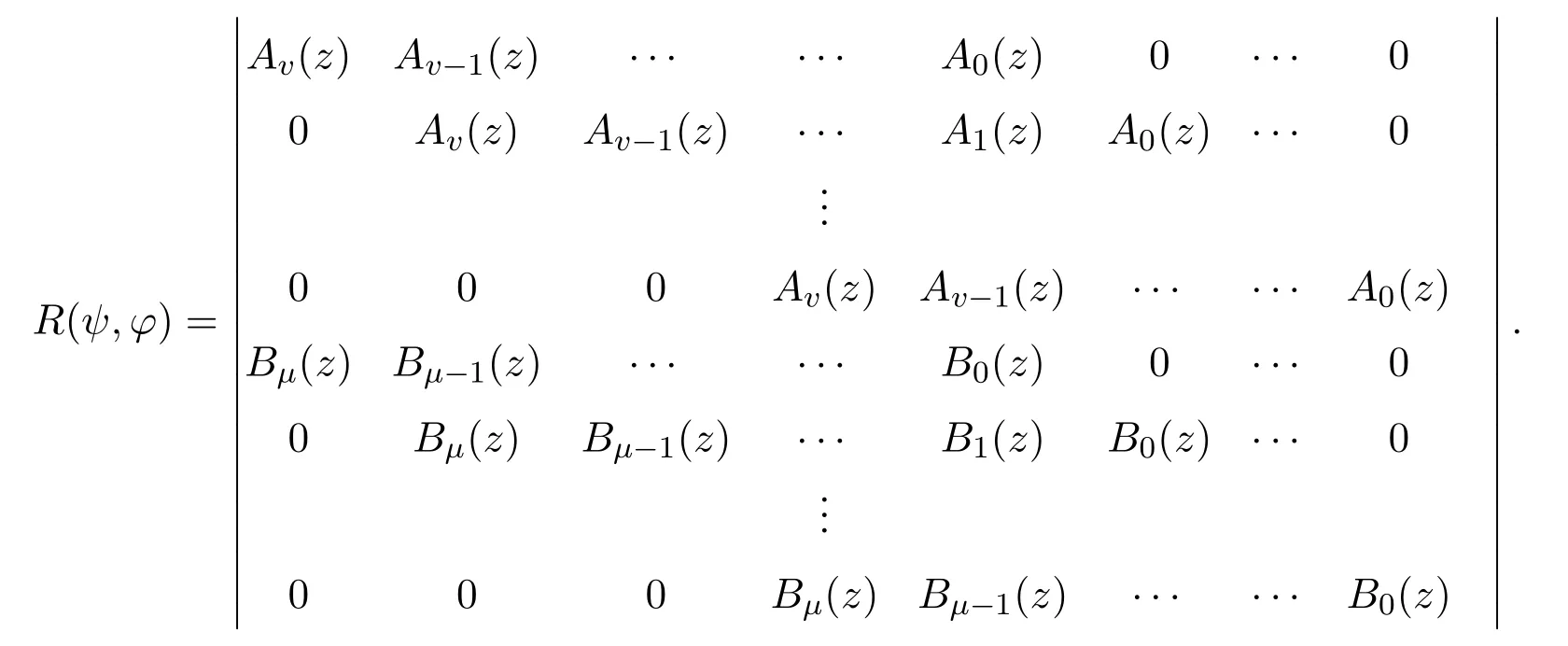
So we know thatR(ψ,φ)is a holomorphic function,then we have
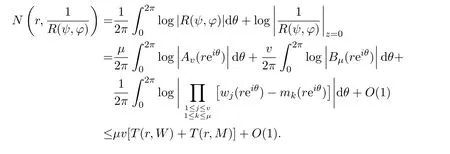
Then we have

So we get

then it must beW(z)(z).
Corollary 3.1LetW(z)andM(z)be twov-valued strong general type algebroid functions on the complex plane C,α(z)∈(S(W)∩S(M))∪{∞}.If

then we haveW(z)≡M(z).
Theorem 3.2LetW(z)andM(z)be twov-valued strong general type algebroid functions on the complex plane C,αj(z)(j=1,2,···,3v+3)∈(S(W)∩S(M))∪{∞}are 3v+3 distinct meromorphic functions.If

and
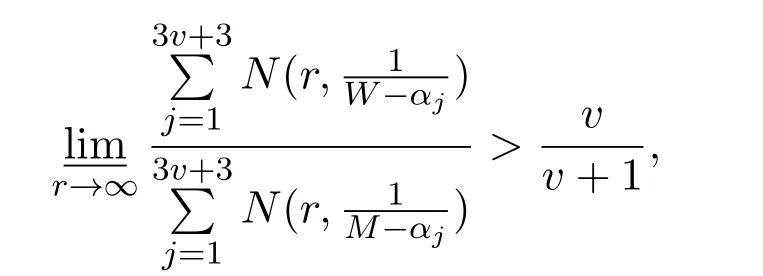
then we haveW(z)≡M(z).
ProofIfW(z)(z),ε∈(0,1)is a sufficiently small positive number then by Theorem 1.5 we have
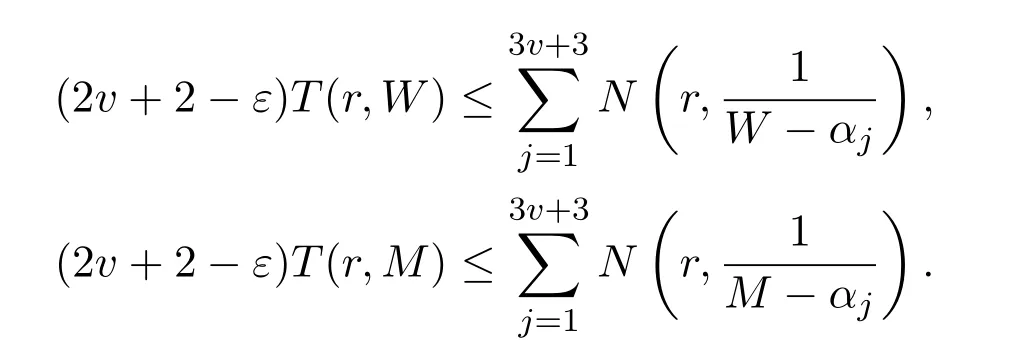
So we get

On the other hand,by(3)we have

Which contradicts with(4),so it must beW(z)≡M(z).
Theorem 3.3LetW(z)andM(z)be twov-valued strong general type algebroid functions on the complex plane C,α(z)∈(S(W)∩S(M))∪{∞}.If

then we haveW(z)≡M(z).
ProofSet

IfW(z)(z),ε∈(0,1)is a sufficiently small positive number and

areqdistinct meromorphic functions,then by Theorem 1.5 we have

Then by(5)and(6)we have

Since

So by(7)and(8)we get

Thus we have

Letε→0,we haveThen by the arbitrariness ofqwe get

On the other hand,by Lemma 2.1 we have

By the definition ofλ(α),(10)and(11)we get

